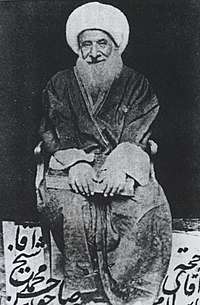Muhammad Hasan al-Najafi
Muhammad Hasan al-Najafi (Arabic: محمد حسن النجفي, romanized: Muḥammad Ḥasan al-Najafī; 1788–1850 AD),[1] author of Jawahir al-kalam fi sharh shara’i‘ al-islam, a 42-volume work on fiqh,[2] was a Shia Marja' and jurist.

Birth
Though the exact date of Muhammad Hasan's birth is unclear, Agha Bozorg Tehrani puts it at around 1212 lunar Hijri (AD 1797). His father, Shaykh Muhammad Baqir Najafi,[3] was the nephew of Abd Al Rahim Sharif, who emigrated from Iran to Iraq. His family lineage includes numerous religious scholars and his brother, Muhammad Hossein, who was killed as a young man. Muhammad Hasan had eight sons, and several daughters.
Scientific movement and Najaf seminary
The appearance of Muhammad Hasan was the result of a development in which some important persons contributed.[4] The Najaf seminary was the place where Akhbarism first appeared at the time when Muhammad Hasan lived in Najaf. In fact, after the establishment of the Usuli school in Shia thought, scholars such as Muhammad Baqir Behbahani, Moḥammad Mahdī Baḥr al-ʿUlūm, and Shaykh Ja'far Kashef al-Ghata developed Usulism from those foundations. When Kashef al-Ghata died, Muhammad Hasan was appointed as the chief of Najaf seminary. Many of the scholars and Ulama supported him for this position. He became very famous after his Excellency Agha Sayyed Ibrahim died. Muhammad Hasan then endorsed the injunctions of the late Ibrahim, and afterward became acquainted with the late Ibrahim's students. Shaykh Ansari was a pupil of Muhammad Hasan and he followed his teacher in managing the seminary.[5]
It is said that the institution of the Marja' in Shi'ism was not centralized until the time of Muhammad Hasan.[6] According to one of his students, during that time he developed the leadership of the Shia. Sayyed Muhammad Nasirabadi believes that Muhammad Hasan had an esoteric relationship with the twelfth Imam.[7]
Opinions
Muhammad Hasan tried to continue the style of thought that has been started by Allamah Hilli: introducing substantial changes in tradition, without breaking the tradition altogether.[8]
Works
Pupils
- Mulla Zayn al-'Abidin al-Mazandarani
- Sayyid Husayn Kuhkamari'i
- Mulla Ali Kani (the author of Idah al-mushtabahat wa tawdih al-maqal)
- Muhammad Irawani
- Shaykh Ja'far al-Shushtari
- Shaykh Jawad (the author of Sharh al-lum'atayn)
- Shaykh Muhsin Khanfar
- Shaykh Muhsin A'sam (the author of Kashf al-falam)
- Sayyid Asad Allah Isfahani
- Shaykh al-'Iraqiyyin
- Shaykh Hasan al-Mamaqani
- Sayyid Husayn Bahr al-'Ulum
- Sayyid Mahmud al-Burujirdi
- Mulla Ali al-Khalili
- Sayyid Ibrahim Shari'atmadar al-Sabziwari
- Shaykh Murtaza Shushtari Ansari[10]
References
- Muḥammad Ḥusayn Ḥusaynī Farāhānī; Hafez Farmayan; Elton L. Daniel (1990). A Shi'ite Pilgrimage to Mecca, 1885-1886: The Safarnâmeh of Mirzâ Mo Ammad Osayn Farâhâni. p. 73.
- Sachedina, Abdulaziz Abdulhussein (1988). "Introduction". The Just Ruler in Shî‘ite Islam. Oxford University Press. p. 22.
- Muḥammad Ḥusayn Ḥusaynī Farāhānī; Hafez Farmayan; Elton L. Daniel (1990). A Shi'ite Pilgrimage to Mecca, 1885-1886: The Safarnâmeh of Mirzâ Mo Ammad Osayn Farâhâni. p. 73.
- Denis MacEoin (2009). The Messiah of Shiraz: Studies in Early and Middle Babism,Volume 3 of Iran Studies. Brill. p. 53.
- Said Amir Arjomand (1988). Authority and Political Culture in Shi'ism. SUNY Press. p. 113.
- ʻAbd al-Hādī Ḥāʼirī (1977). Shīʿīsm and Constitutionalism in Iran: A Study of the Role Played by the Persian Residents of Iraq in Iranian Politics. Brill Archive. p. 63.
- Juan Cole (2002). Sacred Space And Holy War: The Politics, Culture and History of Shi'ite Islam. I.B.Tauris. p. 93.
- Hamid Mavani (2013). Religious Authority and Political Thought in Twelver Shi'ism: From Ali to Post-Khomeini. Routledge.
- Gholamali Haddad Adel, Mohammad Jafar Elmi, Hassan Taromi-Rad (2012). Hawza-yi ‘Ilmiyya, Shi‘i Teaching Institution: An Entry from Encyclopaedia of the World of Islam. p. 290.CS1 maint: uses authors parameter (link)
- Hamid Algar (1980). Religion and State in Iran, 1785-1906: The Role of the Ulama in the Qajar Period. p. 163.